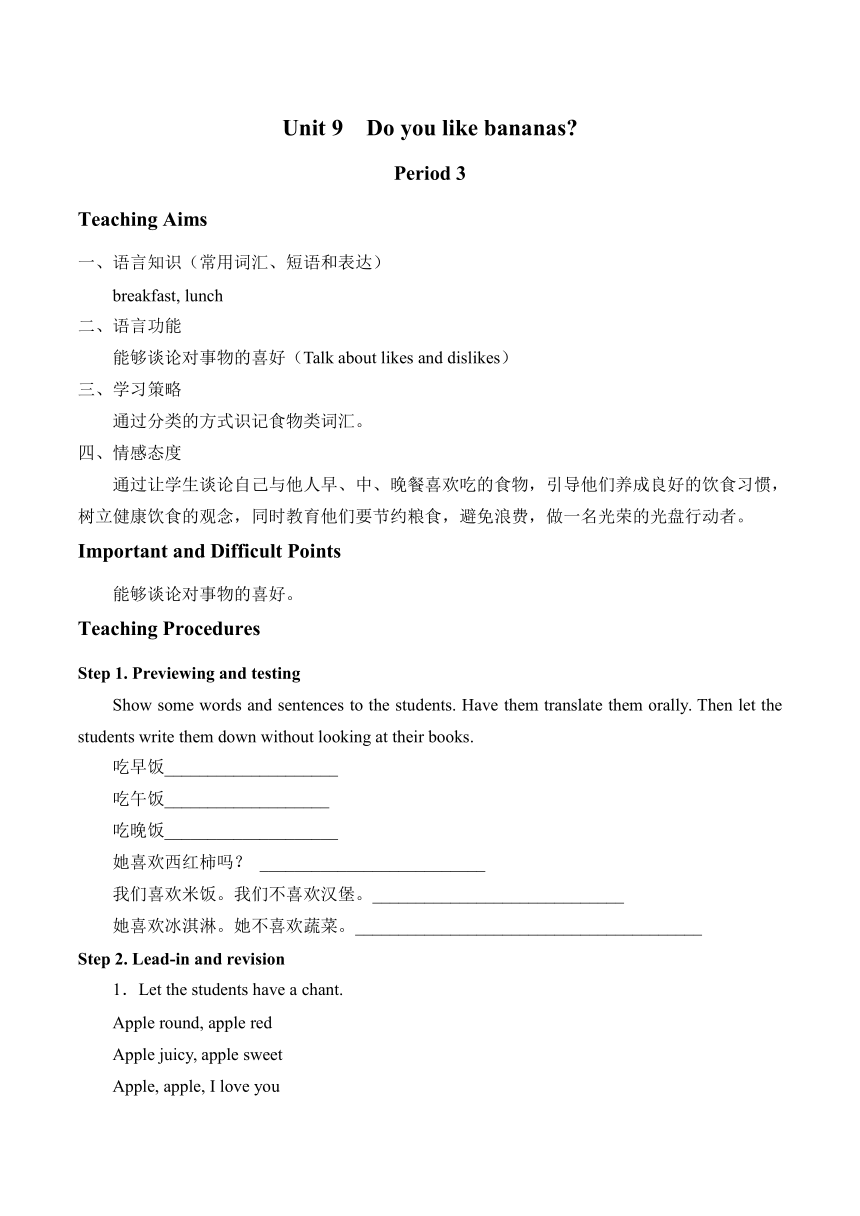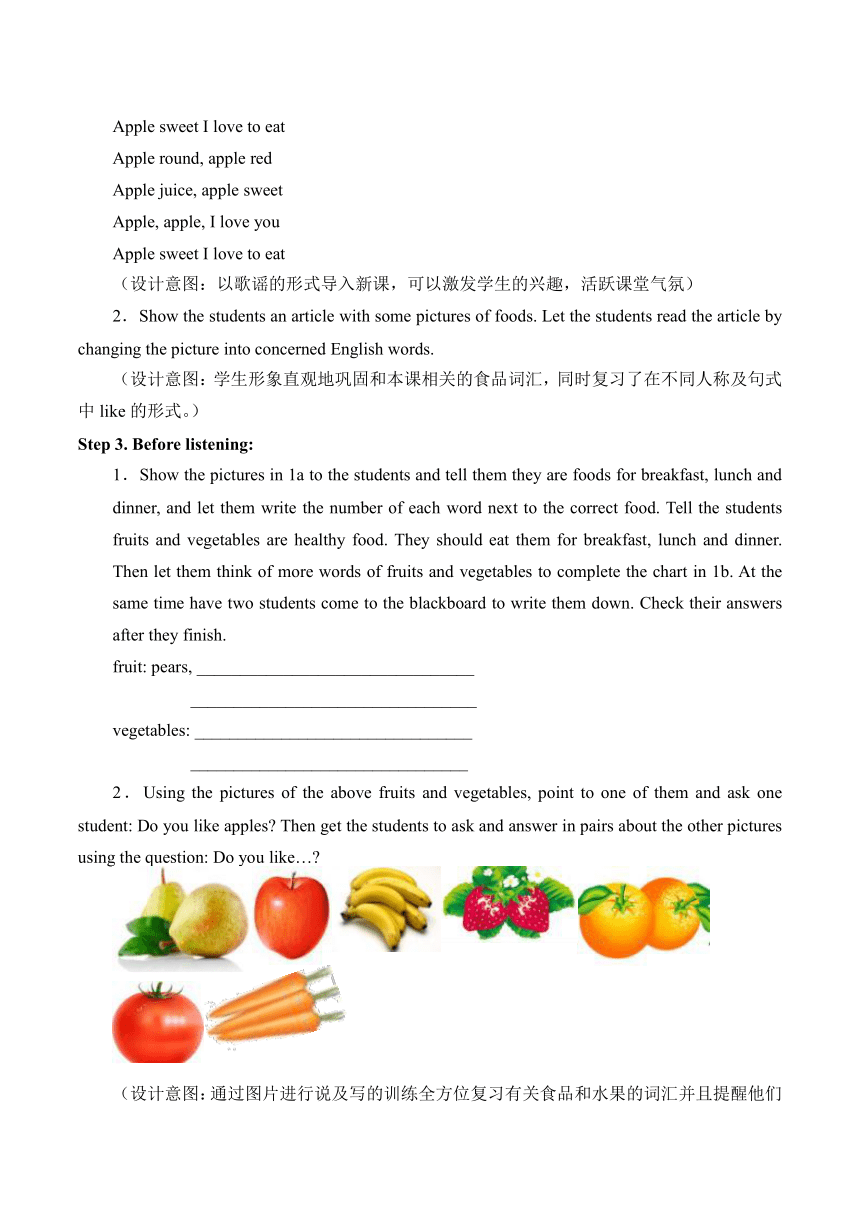Unit 9 Do you like bananas-Period 3 教案
文档属性
| 名称 | Unit 9 Do you like bananas-Period 3 教案 |  | |
| 格式 | doc | ||
| 文件大小 | 166.0KB | ||
| 资源类型 | 教案 | ||
| 版本资源 | 鲁教版 | ||
| 科目 | 英语 | ||
| 更新时间 | 2022-10-18 10:13:23 | ||
图片预览


文档简介
Unit 9 Do you like bananas
Period 3
Teaching Aims
一、语言知识(常用词汇、短语和表达)
breakfast, lunch
二、语言功能
能够谈论对事物的喜好(Talk about likes and dislikes)
三、学习策略
通过分类的方式识记食物类词汇。
四、情感态度
通过让学生谈论自己与他人早、中、晚餐喜欢吃的食物,引导他们养成良好的饮食习惯,树立健康饮食的观念,同时教育他们要节约粮食,避免浪费,做一名光荣的光盘行动者。
Important and Difficult Points
能够谈论对事物的喜好。
Teaching Procedures
Step 1. Previewing and testing
Show some words and sentences to the students. Have them translate them orally. Then let the students write them down without looking at their books.
吃早饭____________________
吃午饭___________________
吃晚饭____________________
她喜欢西红柿吗? __________________________
我们喜欢米饭。我们不喜欢汉堡。_____________________________
她喜欢冰淇淋。她不喜欢蔬菜。________________________________________
Step 2. Lead-in and revision
1.Let the students have a chant.
Apple round, apple red
Apple juicy, apple sweet
Apple, apple, I love you
Apple sweet I love to eat
Apple round, apple red
Apple juice, apple sweet
Apple, apple, I love you
Apple sweet I love to eat
(设计意图:以歌谣的形式导入新课,可以激发学生的兴趣,活跃课堂气氛)
2.Show the students an article with some pictures of foods. Let the students read the article by changing the picture into concerned English words.
(设计意图:学生形象直观地巩固和本课相关的食品词汇,同时复习了在不同人称及句式中like的形式。)
Step 3. Before listening:
1.Show the pictures in 1a to the students and tell them they are foods for breakfast, lunch and dinner, and let them write the number of each word next to the correct food. Tell the students fruits and vegetables are healthy food. They should eat them for breakfast, lunch and dinner. Then let them think of more words of fruits and vegetables to complete the chart in 1b. At the same time have two students come to the blackboard to write them down. Check their answers after they finish.
fruit: pears, ________________________________
_________________________________
vegetables: ________________________________
________________________________
2.Using the pictures of the above fruits and vegetables, point to one of them and ask one student: Do you like apples Then get the students to ask and answer in pairs about the other pictures using the question: Do you like…
(设计意图:通过图片进行说及写的训练全方位复习有关食品和水果的词汇并且提醒他们养成良好的饮食习惯;同时创造真实的语言环境引导学生训练询问喜好的句型,为下一步听的顺利进行做好铺垫。)
Step 4. While-listening
Conclude the above teaching step: We like different fruits and different vegetables. Show the students two photos of two kids. Tell them they are Tom and Sally. They are talking about food. Get the students to listen to their conversation.
1.Listen for the general idea.
The main idea of the conversation is __________.
A.Tom’s likes
B.Tom and Sally’s likes and dislikes
C.Sally’s dislikes
(设计意图:让学生通过听录音整体感知,并找出谈论的主旨大意。听听力之前要对学生进行相关听力策略(在听听力之前先仔细审题,找出需要听的关键词,即用下划线标注的词)的指导。这样能提高学生整体理解听力内容的能力,并能提高学生的听力效能。)
2.Listen for the specific idea.
(1)Listen and circle the food they hear in 1a.
(2)Listen again. Fill in the chart.
Likes Doesn’t like
Tom carrots
Sally
Check their answers and ask the students to answer with complete sentences, e.g.: Tom likes carrots and salad. (设计意图:第二次听,在听听力之前,一定注意给予听力策略的指导:即注重关键词,然后学生根据听力内容来回答。在核对答案的同时练习了目标语言。)
(3)Get the students to listen to the tape a third time and let them complete the tape scripts.
S: Do you like carrots
T: Yes, I do. I like all ______________.
S: How about _______ Do you like ________
T: Yes, I do. It’s great. Do you like vegetables
S: I ________ _________ vegetables. Well, only salad. But I like __________. I like __________ __________.
T: How about __________ I don’t like apples.
S: Yes, I like apples. And do you know what I really like
T: What
S: Ice-cream.
(4)Get the students to listen to the tape and repeat after it sentence by sentence.
(设计意图:听力理解先让学生听大意,然后再听细节,初步用听的技能获取、处理和传递所需信息。最后再进行听力模仿,让学生感知英语发音特点,提高口语表达水平。)
Step 5. Post-listening activities
1.Pair work
(1)Get several pairs of students read the tape scripts.
(2)Let the students work in pairs again to ask and answer about Tom’s and Sally’s likes and dislikes. Guide them to use the questions: Does Tom/ Sally like…
2.Writing practice
Go on using the chart in 1d and ask the students to write short article about Tom’s and Sally’s eating habit. Show them the beginning of the article: I have two good friends Tom and Sally. They like different foods. Tom likes… After that, make several individuals read their articles.
(设计意图:本部分的内容重在培养学生们口头表达能力与写的能力,同时引导学生更好地内化语言知识。)
3.Group work
Have the students work in groups of four. Let them make a survey in their groups about their own and their partners’ likes and dislikes about food by asking: Do you like… Have them to fill in the following chart:
After that let the students make a report about what they’ve surveyed. (设计意图:听力练习后让学生模仿听力内容进行采访并写出采访报告,达到学以致用的目的。)
Step 6. Inquiry into knowledge by translation
--Does Tom like carrots --Yes, he does.
______________________________________________________
此处does为_______词,帮助构成一般疑问句。其肯定回答和否定回答都要用does来完成。此句的肯定句是“_______________”。
like用______________形式。
The answers to the inquiry into knowledge by translation:
汤姆喜欢胡萝卜吗?是的,他喜欢。
助动,Tom likes carrots. 第三人称单数。
(设计意图:引导学生讨论并进行小组合作,一步步提升他们的各种应用能力,巩固本节课的语言知识,并为下节课的学习做好了铺垫。)
Homework
1.State the foods you like and you don’t like.
2.State the foods your family like and they don’t like.
3.Preview 2d, Section B.
Hi!
Hello!
PAGE
Period 3
Teaching Aims
一、语言知识(常用词汇、短语和表达)
breakfast, lunch
二、语言功能
能够谈论对事物的喜好(Talk about likes and dislikes)
三、学习策略
通过分类的方式识记食物类词汇。
四、情感态度
通过让学生谈论自己与他人早、中、晚餐喜欢吃的食物,引导他们养成良好的饮食习惯,树立健康饮食的观念,同时教育他们要节约粮食,避免浪费,做一名光荣的光盘行动者。
Important and Difficult Points
能够谈论对事物的喜好。
Teaching Procedures
Step 1. Previewing and testing
Show some words and sentences to the students. Have them translate them orally. Then let the students write them down without looking at their books.
吃早饭____________________
吃午饭___________________
吃晚饭____________________
她喜欢西红柿吗? __________________________
我们喜欢米饭。我们不喜欢汉堡。_____________________________
她喜欢冰淇淋。她不喜欢蔬菜。________________________________________
Step 2. Lead-in and revision
1.Let the students have a chant.
Apple round, apple red
Apple juicy, apple sweet
Apple, apple, I love you
Apple sweet I love to eat
Apple round, apple red
Apple juice, apple sweet
Apple, apple, I love you
Apple sweet I love to eat
(设计意图:以歌谣的形式导入新课,可以激发学生的兴趣,活跃课堂气氛)
2.Show the students an article with some pictures of foods. Let the students read the article by changing the picture into concerned English words.
(设计意图:学生形象直观地巩固和本课相关的食品词汇,同时复习了在不同人称及句式中like的形式。)
Step 3. Before listening:
1.Show the pictures in 1a to the students and tell them they are foods for breakfast, lunch and dinner, and let them write the number of each word next to the correct food. Tell the students fruits and vegetables are healthy food. They should eat them for breakfast, lunch and dinner. Then let them think of more words of fruits and vegetables to complete the chart in 1b. At the same time have two students come to the blackboard to write them down. Check their answers after they finish.
fruit: pears, ________________________________
_________________________________
vegetables: ________________________________
________________________________
2.Using the pictures of the above fruits and vegetables, point to one of them and ask one student: Do you like apples Then get the students to ask and answer in pairs about the other pictures using the question: Do you like…
(设计意图:通过图片进行说及写的训练全方位复习有关食品和水果的词汇并且提醒他们养成良好的饮食习惯;同时创造真实的语言环境引导学生训练询问喜好的句型,为下一步听的顺利进行做好铺垫。)
Step 4. While-listening
Conclude the above teaching step: We like different fruits and different vegetables. Show the students two photos of two kids. Tell them they are Tom and Sally. They are talking about food. Get the students to listen to their conversation.
1.Listen for the general idea.
The main idea of the conversation is __________.
A.Tom’s likes
B.Tom and Sally’s likes and dislikes
C.Sally’s dislikes
(设计意图:让学生通过听录音整体感知,并找出谈论的主旨大意。听听力之前要对学生进行相关听力策略(在听听力之前先仔细审题,找出需要听的关键词,即用下划线标注的词)的指导。这样能提高学生整体理解听力内容的能力,并能提高学生的听力效能。)
2.Listen for the specific idea.
(1)Listen and circle the food they hear in 1a.
(2)Listen again. Fill in the chart.
Likes Doesn’t like
Tom carrots
Sally
Check their answers and ask the students to answer with complete sentences, e.g.: Tom likes carrots and salad. (设计意图:第二次听,在听听力之前,一定注意给予听力策略的指导:即注重关键词,然后学生根据听力内容来回答。在核对答案的同时练习了目标语言。)
(3)Get the students to listen to the tape a third time and let them complete the tape scripts.
S: Do you like carrots
T: Yes, I do. I like all ______________.
S: How about _______ Do you like ________
T: Yes, I do. It’s great. Do you like vegetables
S: I ________ _________ vegetables. Well, only salad. But I like __________. I like __________ __________.
T: How about __________ I don’t like apples.
S: Yes, I like apples. And do you know what I really like
T: What
S: Ice-cream.
(4)Get the students to listen to the tape and repeat after it sentence by sentence.
(设计意图:听力理解先让学生听大意,然后再听细节,初步用听的技能获取、处理和传递所需信息。最后再进行听力模仿,让学生感知英语发音特点,提高口语表达水平。)
Step 5. Post-listening activities
1.Pair work
(1)Get several pairs of students read the tape scripts.
(2)Let the students work in pairs again to ask and answer about Tom’s and Sally’s likes and dislikes. Guide them to use the questions: Does Tom/ Sally like…
2.Writing practice
Go on using the chart in 1d and ask the students to write short article about Tom’s and Sally’s eating habit. Show them the beginning of the article: I have two good friends Tom and Sally. They like different foods. Tom likes… After that, make several individuals read their articles.
(设计意图:本部分的内容重在培养学生们口头表达能力与写的能力,同时引导学生更好地内化语言知识。)
3.Group work
Have the students work in groups of four. Let them make a survey in their groups about their own and their partners’ likes and dislikes about food by asking: Do you like… Have them to fill in the following chart:
After that let the students make a report about what they’ve surveyed. (设计意图:听力练习后让学生模仿听力内容进行采访并写出采访报告,达到学以致用的目的。)
Step 6. Inquiry into knowledge by translation
--Does Tom like carrots --Yes, he does.
______________________________________________________
此处does为_______词,帮助构成一般疑问句。其肯定回答和否定回答都要用does来完成。此句的肯定句是“_______________”。
like用______________形式。
The answers to the inquiry into knowledge by translation:
汤姆喜欢胡萝卜吗?是的,他喜欢。
助动,Tom likes carrots. 第三人称单数。
(设计意图:引导学生讨论并进行小组合作,一步步提升他们的各种应用能力,巩固本节课的语言知识,并为下节课的学习做好了铺垫。)
Homework
1.State the foods you like and you don’t like.
2.State the foods your family like and they don’t like.
3.Preview 2d, Section B.
Hi!
Hello!
PAGE
同课章节目录
- Unit 1 Good morning
- Section A
- Section B
- Unit 2 What's this in English?
- Section A
- Section B
- Unit 3 What color is it?
- Section A
- Section B
- Unit 4 My name's is Gina
- Section A
- Section B
- Unit 5 This is my siste
- Section A
- Section B
- Unit 6 Is this your pencil?
- Section A
- Section B
- Unit 7 Where's my schoolbag?
- Section A
- Section B
- Unit 8 Do you have a soccer ball?
- Sectioan A
- Sectioan B
- Unit 9 Do you like bananas?
- Section A
- Section B
- Unit 10 How much are these socks?
- Section A
- Section B
